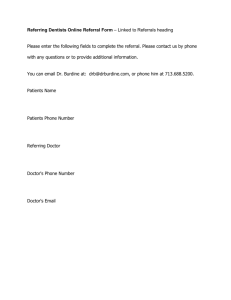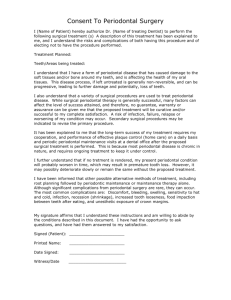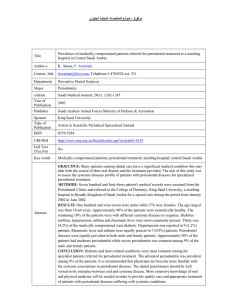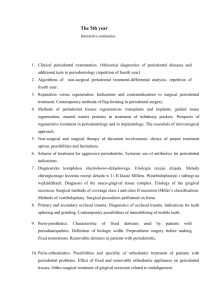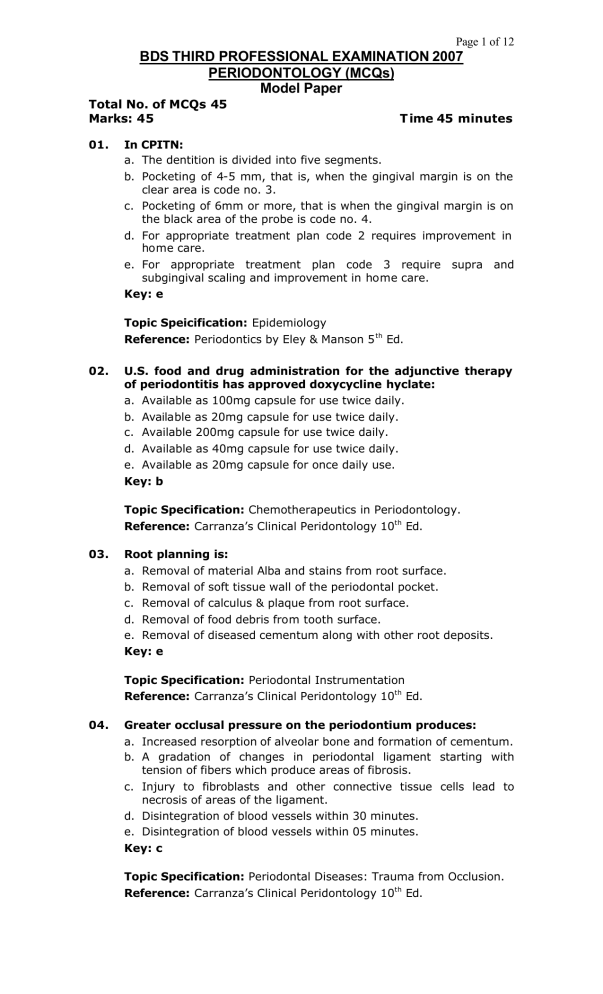
Page 1 of 12 BDS THIRD PROFESSIONAL EXAMINATION 2007 PERIODONTOLOGY (MCQs) Model Paper Total No. of MCQs 45 Marks: 45 01. T ime 45 minutes In CPITN: a. The dentition is divided into five segments. b. Pocketing of 4-5 mm, that is, when the gingival margin is on the clear area is code no. 3. c. Pocketing of 6mm or more, that is when the gingival margin is on the black area of the probe is code no. 4. d. For appropriate treatment plan code 2 requires improvement in home care. e. For appropriate treatment plan code 3 require supra and subgingival scaling and improvement in home care. Key: e Topic Speicification: Epidemiology Reference: Periodontics by Eley & Manson 5 th Ed. 02. U.S. food and drug administration for the adjunctive therapy of periodontitis has approved doxycycline hyclate: a. Available as 100mg capsule for use twice daily. b. Available as 20mg capsule for use twice daily. c. Available 200mg capsule for use twice daily. d. Available as 40mg capsule for use twice daily. e. Available as 20mg capsule for once daily use. Key: b Topic Specification: Chemotherapeutics in Periodontology. Reference: Carranza’s Clinical Peridontology 10th Ed. 03. Root planning is: a. Removal of material Alba and stains from root surface. b. Removal of soft tissue wall of the periodontal pocket. c. Removal of calculus & plaque from root surface. d. Removal of food debris from tooth surface. e. Removal of diseased cementum along with other root deposits. Key: e Topic Specification: Periodontal Instrumentation Reference: Carranza’s Clinical Peridontology 10th Ed. 04. Greater occlusal pressure on the periodontium produces: a. Increased resorption of alveolar bone and formation of cementum. b. A gradation of changes in periodontal ligament starting with tension of fibers which produce areas of fibrosis. c. Injury to fibroblasts and other connective tissue cells lead to necrosis of areas of the ligament. d. Disintegration of blood vessels within 30 minutes. e. Disintegration of blood vessels within 05 minutes. Key: c Topic Specification: Periodontal Diseases: Trauma from Occlusion. Reference: Carranza’s Clinical Peridontology 10th Ed. Page 2 of 12 BDS THIRD PROFESSIONAL EXAMINATION 2007 PERIODONTOLOGY (MCQs) Model Paper 05. Endocarditis prophylaxis is recommended in: a. Mitral valve prolapse without valvular regurgitation. b. Previous coronary artery bypass graft surgery c. Cardiac pacemakes. d. Implanted defibrillators. e. Tetralogy of Fallot. Key: e Topic Specification:Periodontal Therapy for Medically Compromised. Reference: Carranza’s Clinical Peridontology 10th Ed. 06. The mobility of the teeth is graded 3 if: a. The mobility is 1mm. b. The mobility is less than 1mm. c. The mobility is in apicoocclusal direction and 1mm in labiolingual direction. d. The mobility is in apicoocclusal direction and mobility is less than 1mm in labio -lingual direction. e. The mobility is in apicoocclusal direction and mobility in labio lingual direction is more than 2mm. Key: e Topic Specification: Periodontal Diagnosis. Reference: Carranza’s Clinical Peridontology 10th Ed. 07. The wavelength of the CO 2 laser used for gingivectomy is: a. 10,600nm. b. 1064nm. c. 10nm. d. 100nm. e. 500nm. Key: a Topic Specification: Periodontal Surgery Gingivectomy Reference: Carranza’s Clinical Peridontology 10th Ed. 08. Localized aggressive periodontitis is best treated in early stage by: a. Tetracycline 250mg 4 times daily for fourteen days. b. Tetracycline 250mg once daily for 7 days. c. Tetracycline 250mg twice daily for 7 days. d. Tetracycline 250mg 4 times daily for 3 days. e. Tetracycline 250mg 4 times daily for 5 days. Key: a Topic Specification: Periodontal Therapy. Reference: Carranza’s Clinical Peridontology 10th Ed. Page 3 of 12 BDS THIRD PROFESSIONAL EXAMINATION 2007 PERIODONTOLOGY (MCQs) Model Paper 09. Furcation involvement is measured by: a. WHO probe. b. CPITN probe. c. Naber’s probe. d. Michigan “O” probe. e. Periodontal explorer. Key: c Topic Specification: Furcation Involvement. Reference: Carranza’s Clinical Peridontology 10th Ed. 10. Classically the epithelial rete ridges show a saw tooth appearance, hyperkeratosis or parakeratosis, hydropic degeneration of basal layer and a dense band like infiltrate of Tlymphocytes microscopically in: a. Pemphigus. b. Pemphigoid. c. Linear IgA disease. d. Lichen planus. e. Chronic ulcerative stomatitis. Key: d Topic Specification: Periodontal Diseases: Desquamative Gingivitis Reference: Carranza’s Clinical Peridontology 10th Ed. 11. Vincent’s angina is a fusospirochetal infection of: a. Marginal gingival. b. Oropharynx and throat. c. Heart. d. Larynx and colon. e. Middle ear and small intestine. Key: b Topic Specification: Periodontal Diseases: Acute Gingival Infections, Differential Diagnosis of Anug. Reference: Carranza’s Clinical Peridontology 10th Ed. 12. The bacteria detected in localized aggressive periodontitis are: a. Borrelia vincenti, medium size spirochetes. b. Fusiformis, Tanerella forsythus. c. Actinobacillus actinomycetemcomitans, capnocytophaga Spp., Eikenella corrodens, campylobacter rectus, prevotella intermedia. d. Mycoplasma, capnocytophaga sputigena, spirocheles. e. Treponema denticola, fusobacterium nucleatum, C. rectus, Actinobacillus Actinomycetem co mitans. Key: c Topic Specification: Periodontal Diseases: Aggressive Periodontitis. Reference: Carranza’s Clinical Peridontology 10th Ed. Page 4 of 12 BDS THIRD PROFESSIONAL EXAMINATION 2007 PERIODONTOLOGY (MCQs) Model Paper 13. Acute periodontal abscess is treated by: a. Gingivoplasty. b. Gingivectomy. c. Periodontal flap procedure. d. Antibiotics. e. Drainage through the gingival sulcus or by an external incision. Key: e Topic Specification: Periodontal Diseases: Gingival Enlargements, Periodontal Abscess. Reference: Carranza’s Clinical Peridontology 10th Ed. 14. Tumor metastasing to gingiva is/are: a. Papilloma. b. Central giant cell carcinoma of the jaw. c. Fibroma. d. Lipoma. e. Adenocarcinoma of colo n, renal cell carcinoma, hypernephroma, lung carcinoma. Key: e Topic Specification: Periodontal Diseases: Gingival Enlargement. Reference: Carranza’s Clinical Peridontology 10th Ed. 15. Periodontal destruction is considered moderate when: a. 3-4mm of clinical attachment loss has occurred in periodontitis. b. 1-2mm of clinical attachment loss has occurred in peroidontitis. c. 5mm or more of clinical attachment loss has occurred in periodontitis. d. 0-1mm of clinical attachment loss has occurred. e. 0.5-0.9mm of clinical attachment loss has occurred in periodontitis. Key: a chronic chronic chronic chronic Topic Specification: Periodontal Diseases: Chronic Periodontitis. Reference: Carranza’s Clinical Peridontology 10th Ed. 16. Primary endodotic lesion requires: a. Minor periodontal treatment only. b. Periodontal surgical treatment only. c. A combined periodontal and endodontic treatment. d. Endodontic treatment only. e. A periodontal flap procedure. Key: d Topic Specification: Periodontal Diseases: Endo-Perio Lesions. Reference: Carranza’s Clinical Peridontology 10th Ed. Page 5 of 12 17. BDS THIRD PROFESSIONAL EXAMINATION 2007 PERIODONTOLOGY (MCQs) Model Paper False gingival enlargement is caused by: a. Underlying drug induced gingival enlargement. b. Underlying inflammation of periodontal ligament. c. Underlying dental and osseous structures. d. By epulis. e. Sarcoidosis. Key: c Topic Specification: Periodontal Diseases: Gingival Enlargement. Reference: Carranza’s Clinical Peridontology 10th Ed. 18. Hypophosphatasia is characterized by: a. High level of serum alkaline phosphatase and phosphoethanolamine. b. Low level of serum alkaline phosphatase and high level of phosphoehtanolamine. c. Low level of serum alkaline phosphatase and low level of phosphoethanolamine. d. High level of alkaline phosphatase and low level of phosphoethanolamine. e. Low level of acid phosphatase and alkaline phosphatase. Key: c Topic Specification: Periodontal Diseases: Systemic Diseases with Periodontal Manifestation. Reference: Carranza’s Clinical Peridontology 10th Ed. 19. Necrotising ulcerative periodontitis: a. Is associated with deep periodontal pockets. b. Is associated with a crater like depression at the tip of interdental papilla and vesicle formation. c. Is associated with a crater like interdental bony depression. d. Is not responsive to any therapy. e. Leads to gingival recession because of faulty tooth brushing. Key: c Topic Specification: Periodontal Diseases: Necrotising Ulcerative Periodontitis. Reference: Carranza’s Clinical Peridontology 10th Ed. 20. Subclinical gingivitis is: a. Characterized by vascular proliferation. b. Characterized by predominantly lymphocytes microscopically. c. Characterized by predominantly plasma cells microscopically. d. Characterized by erythema, bleeding on probing. e. Characterized by increased crevicular fluid flow and infillration of sulcular and junctional epithelium by polymorphonuclear leukocytes. Key: e Topic Specification: Periodontal Pathogenesis: Gingival Inflammation. Reference: Carranza’s Clinical Peridontology 10th Ed. Page 6 of 12 21. BDS THIRD PROFESSIONAL EXAMINATION 2007 PERIODONTOLOGY (MCQs) Model Paper The amount of gingival crevicular fluid is: a. Decreased when inflammation is present. b. Increase by trauma from occlusion. c. Decreased by mastication of coarse foods and smoking. d. Decreased by ovulation and hormonal contraceptives. e. Increased by tooth brushing and gingival massage. Key: e Topic Specification: Periodontal Diseases: Defense Mechanisms of Gingiva: GCF Reference: Carranza’s Clinical Peridontology 10th Ed. 22. Dentogingival unit: a. Is sulcular epithelium and gingival fibers. b. Is junctional epithelium and gingival fibers. c. Is sulcular epithelium and periodontal fibers. d. Is junctional epithelium and periodontal fibers. e. Is oral epithelium and gingival fibers. Key: b Topic Specification: Periodontium in Health. Reference: Carranza’s Clinical Peridontology 10th Ed. 23. Transseptal fibers extend: a. Obliquely from the cementum just beneath the junctional epithe lium to the alveolar crest. b. From the cementum in a coronal direction obliquely to the bone. c. From the cementum to cementum in the furcation areas of the multirooted teeth. d. Interproximally over the alveolar crest and are embedded in cementum of adjacent teeth. e. At right angles to the long axis of the tooth from cementum to the alveolar bone. Key: d Topic Specification: Periodontium in Health Reference: Carranza’s Clinical Peridontology 10th Ed. 24. The growth of porphyromonas gingivalis is enhanced by metabolic by products: a. Succinate from campylo bacter rectus. b. Protoheme from capnocytophaga. c. Protoheme from campylo bacter rectus. d. Succinate from veillonella. e. Protoheme from fusobacterium. Key: c Topic Specification: Etiology of Periodontal Periodontal Microbiology: Interactions of Plaque Bacteria. Reference: Carranza’s Clinical Peridontology 10th Ed. Diseases: Metabolic Page 7 of 12 BDS THIRD PROFESSIONAL EXAMINATION 2007 PERIODONTOLOGY (MCQs) Model Paper 25. Leukemic gingival enlargement: a. Occurs in edentulous areas. b. Occurs in chronic leukemia. c. Occurs by abnormal accumulation of leukemia cells in dermal and subcutaneous connective tissue. d. Occurs by dense cellular accumulation in papillary layer of connective tissue. e. Occurs by dense cellular accumulation in reticular layer of connective tissue. Key: e Topic Specification: Etiology of Periodontal Diseases: Systemic Factors Reference: Carranza’s Clinical Peridontology 10th Ed. 26. A linear (Burtonian line) steel gray gingival pigmentation associated with local inflammation occurs in: a. Bismuth intoxication. b. Lead intoxication. c. Mercury intoxication. d. Arsenic intoxication. e. Chromium intoxication. Key: b Topic Specification: Etiology of Periodontal Diseases: Systemic Factors. Reference: Carranza’s Clinical Peridontology 10th Ed. 27. The initial colo nisers in the dental plaque are: a. Fusobacterium nucleatum, prevotella intermedia. b. Capnocytophaga species, campylobacter rectus. c. Tannerella forsythus, bacterionema maturochottii. d. Streptococcus sanguis, actinomyces viscosus. e. Eikehella corrodens, actinobacills actenomycetem comitans. Key: d Topic Specificaiton: Etiology of Periodontal Disease: Periodontal Microbiology. Reference: Carranza’s Clinical Peridontology 10th Ed. 28. A forcibly embedded tooth brush bristle may be retained in the gingival and cause: a. Gingival recession. b. Periodontal pocket. c. Attachment loss. d. Bone loss. e. Gingival abscess. Key: e Topic Specification: Etiology of Periodontal Diseases: Local Factors. Reference: Carranza’s Clinical Peridontology 10th Ed. Page 8 of 12 29. BDS THIRD PROFESSIONAL EXAMINATION 2007 PERIODONTOLOGY (MCQs) Model Paper Vitamin B deficiency results in: a. Deep periodontal pockets. b. Hemorrhagic diathesis in the gingival. c. Loss of lamina dura. d. Glossitis, glossodynia, gingivitive, inflammation of entire oral mucosa. e. Accelerated gingival wound healing. Key: d Topic Specification: Etiology of Periodontal Diseases: Systemic Factors: Nutritional Factors. Reference: Carranza’s Clinical Peridontolo gy 10th Ed. 30. There is partial or complete loss of lamina dura in: a. Hypoparthyroidism. b. Hyperparathyroidism. c. Beri beri. d. Pellgra. e. Hypervitaminosis D. Key: b Topic Specification: Etiology of Periodontal Diseases: Systemic Factors. Reference: Carranza’s Clinical Peridontology 10th Ed. 31. Mineralization of plaque may start intracellularly in: a. Streptococcus sanguis and actinomyces viscosus species. b. Porphyromonas gingivalis and prevotela intermedia species. c. Diptheroids, bacterionema, veillonella species. d. Borrelia vincenti and actinobacillus actinoemycetum comitans. e. Capnocytophaga and campylobacter rectus and tenneralla forsythus. Key: c Topic Specification: Etiology of Periodontal Diseases: Dental Calculus. Reference: Carranza’s Clinical Peridontology 10th Ed. 32. Severe generalized periodontitis have been reported in: a. Tetralogy of fallot. b. Tetralogy of eisenanonger. c. Initial lesion. d. Early lesion. e. Vitamin A deficiency. Key: b Topic Specification: Peridontal Etiology: Systemic Factors. Reference: Carranza’s Clinical Peridontology 10th Ed. Page 9 of 12 BDS THIRD PROFESSIONAL EXAMINATION 2007 PERIODONTOLOGY (MCQs) Model Paper 33. Mineral precipitation results from a local rise in the degree of saturation of calcium and phosphate ions because: a. A decrease in the pH of the saliva cause precipitation of calcium and phosphate ions. b. An increase in the pH of the saliva cause precipitation of calcium and phosphate ions by lowering of precipitation constant. c. A decrease in pH of saliva lowers precipitation constant leading to precipitation of calcium and phosphate ion. d. An increase in the pH of saliva increases precipitation constant leading to precipitation of calcium and phosphate ions. e. An increase in the pH of saliva with no effect on precipitation constant. Key: b Topic Specification: Etiology of Periodontal Diseases: Dental Calculus. Reference: Carranza’s Clinical Peridontology 10th Ed. 34. The incidence of lingual recession and pocket formation and radiographic evidence of bone loss among subjects with a mean age of 22 years who wore lingual “barbells” for 2 years or more according to camphell et al is: a. 97%. b. 50%. c. 62%. d. 10%. e. 5%. Key: b Topic Specification: Etiology of Periodontal Diseases: Local Factors: Oral Jewelry. Reference: Carranza’s Clinical Peridontology 10th Ed. 35. Non eugenol periodontal dressing: a. The retention is by chemically interlocking in the interdental areas. b. Contact allergy to eugenol has been reported. c. There is asbestos. d. Is placed for two weeks. e. Is placed for one week. Key: e Topic Specification: Periodontal Surgery: Periodonatal Dressing. Reference: Carranza’s Clinical Peridontology 10th Ed. 36. Synthetic resorbable suturing materials in periodontal surgery is: a. Polyglycolic. b. Expanded polytetra fluoroethylene. c. Nylon. d. Polyester. e. Chromic gut. Key: a Topic Specification: Periodontal Surgery: Suturing Materials. Reference: Carranza’s Clinical Peridontology 10th Ed. Page 10 of 12 BDS THIRD PROFESSIONAL EXAMINATION 2007 PERIODONTOLOGY (MCQs) Model Paper 37. Excisional new attachment procedure involves: a. A periodontal flap. b. A free gingival graft. c. A regenerative osseous procedure. d. Root planning. e. Internal bevel incision from the margin of the free gingiva apically to point below bottom of pocket. Key: e Topic Specification: Periodontal Surgery. Reference: Carranza’s Clinical Peridontology 10th Ed. 38. Non bone graft materials used in periodontal surgery include: a. Cartilage, cementum, xenograft. b. Dentin, plaster of paris, allografts. c. Ceramics, coral derived materia ls, autografts. d. Cartilage, sclera, dura, dentin, cementum. e. Xenografts, dentin Key: d Topic Specification: Periodontal Surgery: Osseous Surgery Reference: Carranza’s Clinical Peridontology 10th Ed. 39. Papilla preservation flap: a. Is a conventional flap procedures. b. Is used when narrow interdental spaces are present. c. Is used for teeth with wide interdental spaces. d. Is a partial thickness flap. e. Is a apically displaced flap. Key: c Topic Specification: Periodontal Surgery: Periodontal Flap. Reference: Carranza’s Clinical Peridontology 10th Ed. 40. Guided tissue regeneration involves: a. Formation of cementum with recession of gingiva. b. Epithelial migration on the cementum surface. c. Biomend, a bovine achille’s tendon collagen that resorbs in 4-18 weeks. d. A resective osseous procedure. e. Atrisorb a polyglycolic acid gel. Key: c Topic Specification: Periodontal Surgery: Guided Regeneration. Reference: Carranza’s Clinical Peridontology 10th Ed. Tissue Page 11 of 12 BDS THIRD PROFESSIONAL EXAMINATION 2007 PERIODONTOLOGY (MCQs) Model Paper 41. Average human biologic width is: a. 3mm. b. 2mm. c. 4mm. d. 1mm. e. 0.5mm. Key: b Topic Specification: Restorative-Periodontal Interactions. Reference: Carranza’s Clinical Peridontology 10th Ed. 42. Löe et al found the rate of bone loss to average about: a. 0.2mm a year for facial surfaces and about 0.3mm a proximal surfaces. b. 0.3mm a year for facial surfaces and about 0.2mm a proximal surfaces. c. 0.5mm a year for facial surfaces and about 0.05mm a proximal surfaces. d. 0.1mm a year for facial surfaces and about 1.00mm a proximal surfaces. e. 0.5mm a year for facial surfaces and about 1.5mm a proximal surfaces. Key: a Topic Specification: Periodontal Pathogenesis: Bone Pattern’s of Bone Loss. Reference: Carranza’s Clinical Peridontology 10th Ed. 43. year for year for year for year for year for Loss & The distance between the apical extent of the calculus and alveolar crest in human periodontal pockets is: a. 0.2mm. b. 3mm. c. 1.97mm (=33.16%). d. 4mm. e. 0.02mm. Key: c Topic Specification: Periodontal Pathogenesis: Periodontal Pocket. Reference: Carranza’s Clinical Peridontology 10th Ed. 44. Horizontal bone loss is present in: a. Localized aggressive periodontitis. b. Generalized aggressive periodontitis. c. Infrabony pockets. d. Chronic periodontitis. e. Acute necrotizing ulcerative gingivitis. Key: d Topic Specification: Periodontal Pathogenesis: Bone Patterns of Bone Loss. Reference: Carranza’s Clinical Peridontology 10th Ed. Loss 7 Page 12 of 12 45. BDS THIRD PROFESSIONAL EXAMINATION 2007 PERIODONTOLOGY (MCQs) Model Paper Regional lymphnode enlargement is present in: a. Acute pericronitis. b. Lichen planus. c. Pemphigoid. d. Pemphigus vulgaris. e. Chronic ulcerative stomatitis. Key: a Topic Specification: Periodontal Diseases. Reference: Carranza’s Clinical Peridontology 10th Ed.


